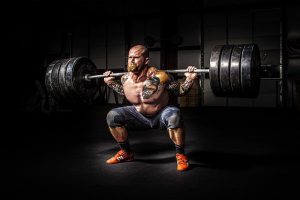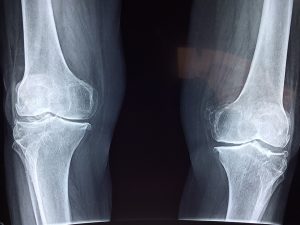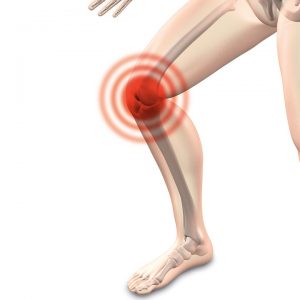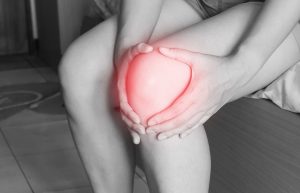You hear it everywhere you turn – if you wanna get big, especially in the lower body, you gotta squat. That’s ok for those with healthy joints, but what about those of us who have to put up with knee pain? Do we have to eliminate this fundamental mass builder from our routine, or is there a way to squat without suffering debilitating knee pain as a consequence?
Let’s find out.

Knee Anatomy
Your knee is a hinge joint, but one that does not have a fixed axis. Instead, it is able to glide and rotate. As a result, the axis of the joint constantly changes. This is one of the prime reasons for knee problems.
In order for your knees to work without giving you too much trouble, you need your hamstring and your quadriceps to be of roughly equal strength. Ideally, you should have a hamstring-to-quadricep ratio of one to one.

The knee is comprised of seven types of tissue:
- Bone – the femur, tibia and patella
- Ligaments – this is the connective tissue that connects bone to bone; there are eight interior ligaments and six external ligaments
- Muscle -while there are no muscles in the actual knee joint, those that act on the knee are the quadriceps and the hamstrings
- Tendon – tendons connect the quadriceps and hamstrings to bones of the knee.
- Bursa – this is a pad-like sac that prevents friction from occurring at the point of connection, such as between bone and muscle. The knee contains twelve of these bursa.
- Adipose tissue – this provides padding around the knee joint
- Articular cartilage – this is the connective tissue that allows for fluid movement between the bones of the knee joint. There are two cartilages on the knee joint; the two menisci which cradle the rounded knobs of the lower femur.
Why the Pain?
The knee joint is stuck between the ankle and the hip. Often the reason that squatters end up with pain in that middle joint has nothing to do with the fact that they have ‘bad knees’. Rather, incorrect movement at the hips and ankles lead to collateral damage to the knee. 90% of the time the issue is with the hips. If you do not have the right mechanics of the hip joint while you squat, your lower body will not be able to stabilize itself when you are squatting. As a result of that, your knees will not be able to track up and down in the ideal plane of movement.
In order to ensure that you are squatting with the correct hip alignment there are two key steps that you need to take:
(1) When you get under the bar be sure that your elbows are pointing downward and into your sides, with your head up. This may seem inconsequential, when in fact it is critical. When your elbows are pointing down, your upper and mid back will automatically come into proper alignment and stabilization.
(2) As you start to go down, consciously pull your body down. To do this, activate the hip flexors and contract and squeezing the psoas muscle. This will allow you to stabilize the lumbar spine.
When you practice those two steps, your knees will track directly up and down when you squat. You will not have to artificially recruit the muscles on the outside of the thigh to push back up. As a result, you will not experience the knee pain that you are used to.
What If You’ve Got Patellar Tendonitis?
Patellar tendonitis will result in stabbing knee pain that goes right through your knee caps into your inner knee joint after doing even light squats. But even that doesn’t mean that you have to forego the squat exercise. The solution to patellar tendonitis pain is to do the box squat.
Patellar tendonitis results from the fact that the tendons attached to the knee are being relied on too much to carry the load of the weight you are squatting. Your goal is for the quads, hamstrings and glutes to take that load. Your job is going to have to be to train those tendons to hold back and allow the muscles to do the job. Squatting to a box will allow you to do just that.

The most common reason that squatters over rely on the patellar tendon is that they have a psychological fear of not being able to get back up during the squat descent. As a result, they rely on the patellar tendon rather than the quads as they are going down. They will bend the knees first because they do not want the quads to take the load. They do not have the confidence that their quads will be strong enough to get them out of the hole. When you use a box, however, that problem is eliminated.
You should squat to a box height of about seventeen inches. You will probably use a bench as your squat box and the height of most benches should be set at about that level. Place the bench between your legs. This will ensure that you are squatting with a wide stance, which will turn out your toes and bring more hip activation into play. Your hips will lead on the descent rather than your knees. Lean back with the hips and then start descending. The bench will provide you with the security that you won’t fall to the ground.
Rather than resting on the box, just touch it with your butt and then power back up, again driving through the hips. Using the box will also recruit more involvement from the hamstrings and glutes.
Knee Tracking
The line of travel of your knee is critical to squatting pain free. You want your knee to be pushed out as you go up and down so that it is in line with your toes. This will minimize any interior or external rotation of the tibia.
Pushing Through the Heels
Inexperienced squatters have a tendency to push through the front of the foot as they push up out of the hole. This is never a good idea and especially not when you are experiencing knee pain. Pushing through the toes will concentrate the tension of the exercise forward and place more stress on the knees.
You should ideally displace your weight over your entire foot. As you drive out of the squat, visualize pushing into the ground through your heels. This will go a long way to helping to achieve the ideal body tracking that you are after.
What About Squatting Shoes?
The shoes that you wear while squatting can have a great impact on your knees while squatting. Most general running or casual shoes do not have the stability or the arch support to lower you to squat efficiently. For many people, their feet have a natural tendency to pronate when they squat. This will also force the knees to come inward. This leads to a chain of problem reactions including strain on the ligaments, excessive sheer force and misaligned tracking of the patellar.
Wearing the right type of squatting shoes can help to prevent these effects.
Squatting shoes also allow you to have a raised heel and a solid heel cup. A solid heel support will stop the heel from moving laterally, which will cause a lot of strain on your knee joint. The raised heel will also place your body in the proper alignment to move up and down with proper patellar tracking.
What About Bar Positioning?
Does the position of the bar on your back affect your knees? Yes, it does. The back squat gives you the choice of either a high bar or a low bar position. The high bar position puts the bar across the upper trapezius muscles, whereas the low bar will have it positioned across the rear delts. With the bar higher, you will end up with a more upright squat position, less hip flexion, and more forward migration of the knee. This is not what you want if your goal is to reduce knee pain.
The low bar squat will naturally result in more forward lean, more hip flexion and less migration of the knee. This is the preferred form to reduce pain in the knee area.
How About Knee Wraps?
Should people with knee pain use knee wraps?
The answer is no – unless you are squatting at more than 85% of your one rep maximum. The problem is that a wrap absorbs the stress and not the tissues of the knee. This means that your tissues never get stronger. If you are going to wear knee wraps be sure to purchase wraps that are heavy as they will provide the greatest level of knee protection. You also want the wrap to have a length of about 18 feet. Allowing you to wrap it around your knee multiple times. You do not, however, want wraps that provide a lot of elastic stretch.
What About Foot Position?
The health of your knees has a direct correlation to your foot stance. At the end of the day, you will have to work out your ideal foot stance in accordance with your own anatomical peculiarities. However, there are some basic foot stance guidelines that you should take into account:
- Point your feet slightly outwards. This is the strongest stance for quad recruitment.
- Do not have an overly wide stance. This will put too much pressure on the patellar tendon.
- Do not allow your knees to cave in during the drive out of the hole. This will place too much pressure on the medial ligament.
- Do not use a close stance. This will place too much compression on the knee.
- Keep your feet locked in position during the set. Do not allow them to fidget around.
Try Front Squats
The front squat is a great exercise that places more emphasis on the quads and less on the hamstrings and glutes. It has also been shown to be less troublesome to the knees. According to a 2009 study . . .
“The front squat was as effective as the back squat in terms of overall muscle recruitment, with significantly fewer compressive forces and extensor moments. The results suggest that front squats may be advantageous compared with back squats for individuals with knee problems such as meniscus tears, and for long-term joint health.”
Warming Up to Prevent Knee Pain
As we’ve already identified one of the main causes for knee pain when squatting has to do with the patellar tendon. Warming the patellar before you get under the rack is vital in order to alleviate the problem. Be sure to do lots of dynamic stretches before you tackle squats.

The Exercises
Here is a non-weight circuit that you can perform in order to loosen up the entire knee area prior to adding weight to your squat.
Partial Pulse Squats x 10
With this move you are only moving through the first 6-8 inches of the squat. You will be pulsing up and down in a ballistic movement.
Side Step Pulse Squats x 10 (each direction)
This is the same movement as the previous exercise, but with every squat, lunge to the side a few inches. Maintain, short, quack and ballistic movements.
Drop Set Pulse Squats x 10 (each direction)
This time as you pulse down you will step back into a quarter turn. Rotate from side to side, allowing your hips to open up.
Jack Pulse Squats x 10
This pulse squat variation involves perform mini jumping jacks as you pulse up and down.
Perform this circuit three times with about 30 seconds of rest between each circuit before you go into your first set of weighted squats and you will take a lot of the pressure off the knees.
Check out this article for ideas on which squat workout is right for you.
Conclusion
Knee pain doesn’t have to mean that you are resigned to missing leg day. It doesn’t even mean that you have to give the squat rack a wide berth. By implementing the guidelines provided in this article, you will be able to squat without the pain. In so doing, you’ll once again be benefiting from the single best exercise for building strength, size and power.